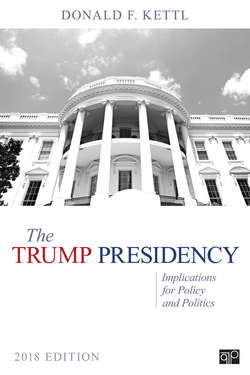Читать книгу The Trump Presidency - Donald F. Kettl - Страница 6
На сайте Литреса книга снята с продажи.
Immigration: The Wall, Religious Tests, and Extreme Vetting
ОглавлениеIf any pledge was the cornerstone of Donald Trump’s 2016 presidential campaign, it was his promise to build a wall between the United States and Mexico—and to make the Mexican government pay for it. It was important for many reasons. It captured a core part of his “Make America Great Again” theme by suggesting one of the reasons that America was not great was because immigrants were taking American jobs and causing crime. And it reflected an important part of his campaign strategy, of floating out big themes in front of big rallies, gauging the audience’s response, and amplifying the themes that got the best reaction. Few themes worked better than the wall.
In fact, Washington Post writer Philip Bump tracked Trump’s ever-growing promises for an ever-bigger wall. He started with a speech in August 2015:
So you take precast plank [of concrete]. It comes 30 feet long, 40 feet long, 50 feet long. You see the highways where they can span 50, 60 feet, even longer than that, right? And do you a beautiful nice precast plank with beautiful everything. Just perfect. . . . . I want it to be so beautiful because maybe someday they’ll call it the Trump Wall.2
And just how tall would the wall be? With tongue firmly in cheek, Bump tracked Trump’s speeches and estimated that the wall would range between 30 and 65 feet, depending on the sweep of the candidate’s rhetoric. The important thing was that the height of the wall was a signal of Trump’s resolve. So too was his pledge to make the Mexican government pay for it, although current and former officials continually said there was no way that was ever going to happen. But as signs of his resolve, the rhetoric constantly brought Trump’s audiences to their feet.
Trump’s promise to build a wall connected tightly with his call in December 2015 to prevent all Muslims from entering the United States until the country can “figure out what is going on,” especially following terrorist attacks in Paris and in San Bernardino, California. Just a few months before, he had said that “I love Muslims.” He surprised many of those following his campaign in arguing that “hatred” of Americans by many Muslims is “beyond comprehension.” Trump argued, “Until we are able to determine and understand this problem and the dangerous threat it poses, our country cannot be the victims of horrendous attacks by people that believe only in jihad, and have no sense of reason or respect for human life.” One of Trump’s primary opponents, Sen. Marco Rubio (R-Fla.), said that Trump’s proposed ban was “offensive and outlandish.” Former governor Jeb Bush (R-Fla.) called Trump “unhinged.” Trump’s ultimate Democratic opponent, Hillary Clinton (D-N.Y.), argued that the ban was “reprehensible, prejudiced and divisive.”3 But Trump found that his supporters applauded the idea, and he continued to promote it throughout the campaign.
Following the proposal to ban Muslims was a plan for “extreme vetting.” Trump pledged to keep the country safe by creating a “screening test” for potential immigrants on whether they held American values on issues ranging from religious freedom, gender equality, and gay rights, among other things. A Trump campaign adviser said, “We have no reason to bring someone into our country who is going to harbor that hostility [toward American values]. We want to bring in people who are reformers or who support moderation or who embrace or expand pluralistic ideas.”4
All of these elements—the plan to build a wall, the pledge to make Mexico pay, the promise of a Muslim ban, and extreme vetting—combined as an appeal to voters. It was an appeal grounded in Americans’ worries about terrorism and fears about their own economic security, all fanned by a concern that the country had lost its greatness—and that immigrants were a large part of the problem. In “Make America Great Again,” he found a slogan that at once captured Americans’ fears and promised that he would put things right.
